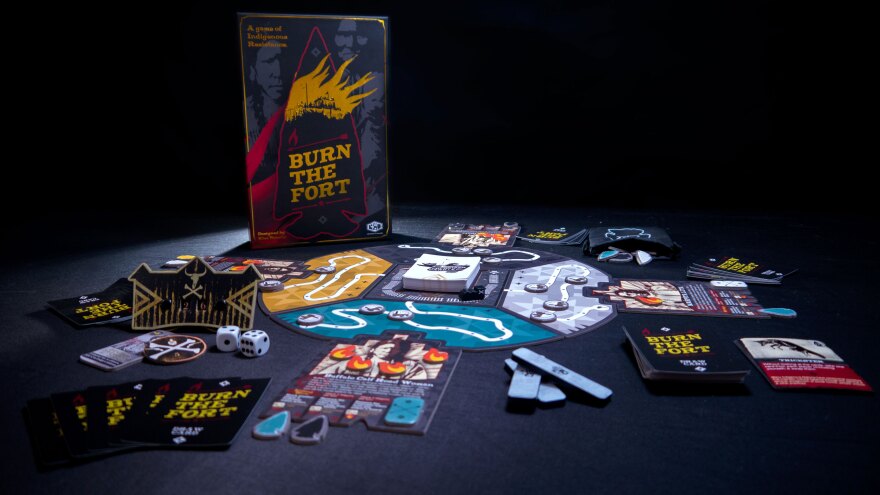A new board game is set to be released in which indigenous warriors fight to stop the impacts of colonialism. Burn the Fort was designed by Klee Benally, a Diné activist based in northern Arizona. He created it because he didn’t see himself or his culture represented in popular games like Monopoly and Settlers of Catan with concepts based on capitalism and resource extraction. Benally also intends for the game to teach Indigenous history and broach hard conversations about colonialism and its impacts.
He spoke to KNAU’s Bree Burkitt about the project.
Bree Burkitt: With most traditional tabletop games, there is a sort of premise that you embark on. What is the premise for this game?
Klee Benally: It’s this game is set during the time of the so-called Indian Wars, which are approximately — depending on who you talk to — 1600s up to the early 1900s. And you play as one of six different indigenous warriors — historic warriors. So, we feature Lozen, who was a spiritual advisor to Geronimo and also a combatant in the so-called Apache wars. We also feature Geronimo, who is known as Goyahkla for Nde' or Apache people. We have a range of other indigenous warriors who are working to stop colonial invasion represented through these wagon tokens that we have on the gameboard that are trying to reach a fort. So basically, you're trying to stop colonial invaders from reaching this fort bringing resources. The theme of the game is deep history — deep history of indigenous resistance, told as indigenous resistors being the protagonist, which isn't typically the case.
BB: And so you mentioned some of these indigenous heroes represented. They're not just limited to Diné. There are Apache figures — it seems to encompass a wide swath of tribes. Why did you think it was important to have that representation of not just one indigenous culture?
KB: Well, because indigenous resistance is diverse. And the history of colonial invasion and occupation is one that has impacted all of us as indigenous peoples throughout what is called Turtle Island or if you talk to Diné peoples, nahasdzáán Mother Earth. I, of course, did decide to feature Hastiin Dághaaʼ . . . And he was a Diné warrior and medicine practitioner who co-led the armed rebellion against the U.S. to resist the forced relocation of the Diné to Hwéeldi or Fort Sumner. So you know, this is the time of The Long Walk, which is intense, tragic time, where we have, you know, forces like Kit Carson invading our land, burning crops, decimating livestock, just starving our people into submission . . . These folks who are portrayed, you know, obviously, in different ways in history, because history is a complex set of narratives told by many different lenses, and typically — as the somewhat cliched statement goes — history is written by the conquerors. And my assertion is, you know, if, if history is written by the conquerors, it'll be unwritten by those who refuse to be conquered. And I believe that there are so many of these powerful narratives that exist with many indigenous peoples that they need to be celebrated in different ways and have a connection to.

BB: How do you get a game like this made? How do you take it from an idea to something tangible?
KB: I've played games all my life, like different kinds of games. Especially because for Diné people, gaming is part of our creation account. We play Keshjee' in the wintertime, which is the shoe game commonly known as, and that game was actually played between different non-human beings that ultimately the outcome of that game determined how we reside, and how there's a balance of day and night essentially. And so gambling is a part of our culture, you could say. . . The idea was sort of a clash of creativity . . . this has been the single most challenging project to put together in terms of putting all of it and the aesthetic elements came together pretty quickly, but the mechanisms, I think, are the most challenging. There are so many different types of game mechanics out there and find the ones that work for you. And that helped to tell the story, right, of the experience that you want the players to have through this narrative. Because to mine gaming is... it's a narrative experience that is also an immersive one.
BB: Oftentimes — maybe not often enough — people will learn about these movements; they'll learn about the history and we see it kind of go over people's heads. Why is it important — or so valuable — to have an opportunity to learn about these events from this sort of alternative, more digestible approach?
The factor is a lot of people don't want to have those hard conversations — they shy away when it becomes unsettling . . . The short cliched response is that, you know, this axiom of, "Those who do not remember the past are condemned to repeat it." I think is a big part of that. So, there are many challenges. I mean, if you look at, you know, Florida, or even here in Arizona, where there have been historic attacks on ethnic studies and now it's, you know, critical race theory. That's a tough conversation. To have it, you know, with a board game as an educational resource tool — it's just one more way of creatively using what we can, I think, to deepen our understandings of these issues. I'm not going to say that a board game is going to change people's hearts and minds, but I think it will open that space to have those conversations and that's my intention.
BB: Klee Benally, thank you so much and good luck with the game.
KB: Yeah, thanks so much
Burn the Fort will be available for purchase later this year. Find more details at burnthefort.com.



